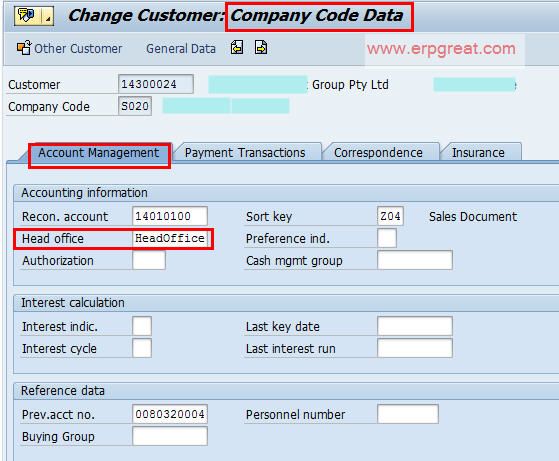Is there any way we could create one customer as the sub of another customer?
My client would like to manage one customer and all of its subsidiaries separately and as a whole at the same time so that they can see the outstanding receivables from each customers and the group at the same time.
Consultant Suggestion:
This is standard head office and branch functionality in the FI customer master records. You just have to put the customer number of the head office in the masters of each branch customer.
To have this issue done you must define customer Y as Customer X Head office account number (in branch accounts).
Go to FD02, Account management tab.

Example:
Configuration steps for head office and branch office accounts in vendor and customer master accounts and how to post an invoice in this configuration.
Assuming you are using SD integration for the billing. Therefore, please go to VD02 for the Child Customer profile under the correct sales org, distribution channel, division.
Then under the Partner functions tab, set the SP Sold to party as the Child, BP Bill to Party as Parent, PY Payer as Parent and SH Ship to party as Child.
If itís only for FI documents configure, then proceed in FD02 only, else if its integrated then use XD02.
Then under the Company code data in the Account management
Tab set the Head office as the Parent. Then all the future postings will
have Acct = Parent but Branch = Child.
Link between Branch Accounts and Head Office Account
To link branch accounts to a head office account, you must enter the number of the head office account in the Head office field in the branch account master record. This field is contained in the company code area of the master record.
The head office account can be any vendor account except one-time accounts or branch accounts themselves. Branch accounts and head office accounts must belong to the same company code.
Line Item Display
When you are entering the parameters for line item display, you should note the following: for head office accounts, enter the key 004 in the field Sort key. This instructs the system to display the line items for the head office account sorted by branch. This key is defined in the table for allocation rules.
Correspondence
You can set up your system to cater for written correspondence with vendors:
a) for the head office, broken down per branch or
b) for each branch individually. If you want to create correspondence (such as dunning notices and account statements) for the individual branches instead of the head office, you have to select the Local processing field in the vendor master record of the head office on the Create Customer: Correspondence screen.
You can also define payment methods in the master records of the branches and head offices. For example, if you want to have certain payment methods for particular branches, enter these in the master records of the branches concerned and do not enter any payment method in the head office master record. If you enter payment methods in both head office and branch master records, all payment methods are possible.
Final notes:
In the Customer and/or Vendor Master data of the Branch office, you need to assign the Head office Master number in Account Mgmt tab in company code segment.
With this configuration all the items posted to a branch account are automatically transferred to the head office account.
All the dunning notices related to the branch go to the head office account and the payments (both incoming & outgoing) are made by the head office.
However if you want the make the dunning and payment programs use the branch account instead, you need to select "decentralized processing" field in "correspondence" tab in the head office master data.
If you set the "account control and status" indicator under "additional selections" in the report for the customer/vendor list (RFDKVZ00 or RFKKVZ00), you can see the possible head offices for each of the branches.